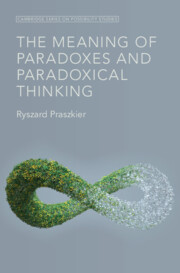Book contents
- The Meaning of Paradoxes and Paradoxical Thinking
- Cambridge series on possibility studies
- The Meaning of Paradoxes and Paradoxical Thinking
- Copyright page
- Contents
- Figures
- Tables
- Acknowledgments
- Introduction
- Part 1 Paradoxes and What They Do to Us
- Part II Sudden Unexpected Changes
- Introduction
- Chapter 4 Abrupt Changes
- Chapter 5 Social Movements and Singularities
- Chapter 6 Early Indicators of Possible Singularities
- Chapter 7 Predicting the Unpredictable
- Discussion and Summary
- Part III Challenging the Impossible
- Part IV Peace and Its Challenges
- Part V Paradoxes and Creativity
- Part VI Paradoxes in Action
- References
- Index
Chapter 7 - Predicting the Unpredictable
from Part II - Sudden Unexpected Changes
Published online by Cambridge University Press: 04 April 2025
- The Meaning of Paradoxes and Paradoxical Thinking
- Cambridge series on possibility studies
- The Meaning of Paradoxes and Paradoxical Thinking
- Copyright page
- Contents
- Figures
- Tables
- Acknowledgments
- Introduction
- Part 1 Paradoxes and What They Do to Us
- Part II Sudden Unexpected Changes
- Introduction
- Chapter 4 Abrupt Changes
- Chapter 5 Social Movements and Singularities
- Chapter 6 Early Indicators of Possible Singularities
- Chapter 7 Predicting the Unpredictable
- Discussion and Summary
- Part III Challenging the Impossible
- Part IV Peace and Its Challenges
- Part V Paradoxes and Creativity
- Part VI Paradoxes in Action
- References
- Index
Summary
Herein are considered some digital methods of predicting singularities in social dynamics; specifically, the Schelling’s computer modeling project. An example of modeling is how the preferences for neighbors of the same race eventually leads, over time, to a completely segregated population. A threshold can be set, assuming that after a certain degree of isolation, the singularity phenomenon appears, making both sides alien and malevolent. Similarly, beyond a certain degree of integration, a singularity point may be defined, creating unity and a harmonious community. A practical application of computer modeling is predicting traffic jams or road catastrophes. Red-teaming is a kind of a prestructured roleplay, providing a methodology to explore the uncertainties and challenge of situations associated with cusp catastrophe occurrences. Some participants take on the role of the partners, others of the competitors. Green-teaming represents open situations, also encompassing cooperative and noncompetitive behaviors. It is pursued through real-life roleplaying games, where participants imagine future situations. This way of playing with the future enables combining individual cognition with social interactions and, as a result, leads to potential aggregated outcomes.
Keywords
- Type
- Chapter
- Information
- The Meaning of Paradoxes and Paradoxical Thinking , pp. 57 - 60Publisher: Cambridge University PressPrint publication year: 2025

